|
CHAPTER FIVE
THE BRINGER OF LIFE
We had seen just how peculiar the Moon is, in so many ways.
Our next
step was to look into how our next-door neighbor in the cosmos
actually affects life on Earth.
First of all we could not ignore the myth that the full Moon brings
out
madness and other evils in the form of more violence, more
suicides, more accidents and more aggression - ideas that are
possibly as old as history itself. The belief that the full Moon
causes mental disorders and strange behavior was particularly
widespread throughout Europe in the Middle Ages.
But is there any scientific evidence to support these beliefs?
There have been many investigations into the subject and some have
produced surprising results.
Research carried out by a medical team at a hospital in Bradford,
England, set out to test the
hypothesis that the incidence of animal bites increases at the time
of a full Moon. Using retrospective observational analysis at their
accident and emergency department they investigated the pattern of
patients who attended from 1997 to 1999 after being bitten by an
animal.
The number of bites in each day was compared with the lunar phase in
each month and they found that the incidence of animal bites rose
significantly at the time of a full Moon. With the period of the
full Moon as the reference point, the incidence rate ratio of the
bites for all other periods of the lunar cycle was significantly
lower. They concluded that the full Moon is associated with a
significant increase in animal bites to humans.16
Of course, we must remember that correlation does not equate to
causation. The pattern they found may be a strange statistical blip
or, even if it is real, it could be entirely coincidental with the
phases of the Moon. Without any suggestion of how the Moon could
cause an increase in anim al aggression towards humans, it is not
possible to consider any connection as proven.
Another study looked into hum an aggression and the lunar synodic
cycle occurring in Dade
County, Florida. Data on five aggressive and/or violent human
behaviors were examined to determine whether a relationship
existed between the two. These included looking at the pattern of
homicides, suicides, fatal traffic accidents, aggravated assaults
and psychiatric emergency room visits.
The team concluded that homicides and aggravated assaults
demonstrated a statistically significant clustering of cases around
the full Moon. Psychiatric emergency room visits clustered around
the first quarter and showed a significantly decreased frequency
around new and full Moon.
The suicide curve showed correlations with both aggravated assaults
and fatal traffic accidents
suggesting, they say, a self-destructive component for each of these
behaviors. The existence of a biological rhythm of human
aggression, which resonates with the lunar synodic cycle was
postulated.17
Whilst these investigations were carried out carefully and
scientifically it is important to
remember that there are dozens of other studies that have failed to
identify similar correlations. If there is some substance behind
lunar myth it is yet to be proven.
However, we feel that such a
relationship is not beyond reason as the Moon exerts considerable
gravitational effects on the Earth creating the tidal movements of
the waters of our oceans, and humans are made up of nearly eighty
per cent water.
Whether or not lunar cycles affect our lives; solar
ones certainly do.
The Four Seasons
At the time of writing these words the leaves on the trees here in
Britain are beginning to be tinged with brown. The days are growing
shorter and the nights are getting longer. As this happens, the
average temperature each day begins to fall and much of our flora
and fauna goes into a dormant state.
Of course, the same seasonal change is happening all across the
northern hemisphere at latitudes between the Tropic of Cancer and
the Arctic Circle.
Meanwhile, countries in the southern hemisphere
are entering spring and new growth is beginning to stir as the days
lengthen and the average daily temperature increases. All of us who
do not live on or near to the equator are familiar with the pattern
of the changing seasons and the effect that these cycles have on the
way we live our lives.
To our ancestors in northern parts of Europe,
Asia and America, the onset of winter must have been a time of fear
and doubt, whilst the first buds of spring would have been a merciful relief with the signal that there would soon be fresh food
to eat.
What most of us don't stop to think about is why seasons happen at
all. It is a common
misunderstanding to imagine it has something to do with how close
the Earth is to the Sun. It is not - it is due to the angle of the
planet in relation to the Sun, which is about 22.5 degrees from what
might be described as a vertical position.
The diagram below shows
how the Earth would look if it was standing upright as it goes
around the Sun, which would mean that the equator of
the Earth would always point straight at the equator of the Sun.
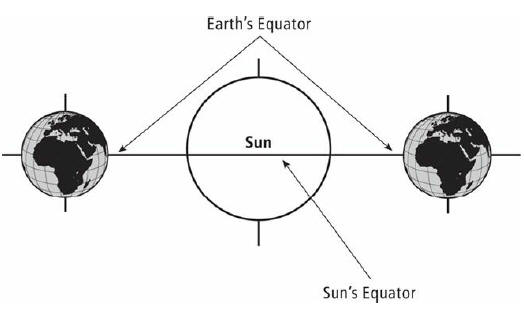
Figure 5
If our planet really did stand in
this position, the bulge of the Sun's equator and that of the Earth
would be closer together than the Sun's poles and the Earth's poles.
The result of this would be a super-hot equatorial temperature on
the Earth, whilst the polar regions of the Earth would be much
colder than they
presently are.
Strangely enough it's not so much a case of the
difference in distance between the Earth and the Sun that matters;
it is more to do with the thickness of the atmosphere above any
given part of the Earth in relationship to the direction of the Sun.
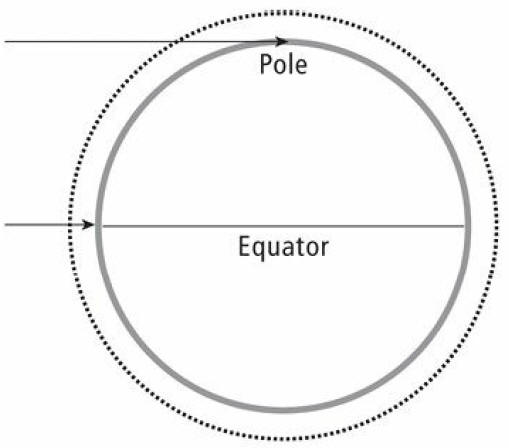
Figure 6
In the imaginary situation above,
sunlight has to travel through far m ore atmosphere to get to the
poles of the Earth than it does to reach the equator, thus greatly
reducing the heat.
Another important factor that reduces the heat at the poles is
diminished power density, where the Sun's energy is dissipated
across a greater area as the Earth curves away from an upright
position.
For example, a circle of sunlight with a one-kilometer
diameter will hit the Earth's surface as a near perfect circle at
the equator, but in extreme northern or southern latitudes it will
be distorted into a long oval due to the curvature of the planet.
This means that the heat of the sunlight at the poles will be
spread over several times the area and therefore be several times
weaker.
The planet Mercury is an excellent example of a world that is
standing virtually upright, in relation to its orbit around the Sun.
Apart from the fact that little Mercury is so close to the Sun, its
angle of inclination, or 'obliquity' as it is more properly called,
would make it a very uncomfortable place for humans.
If it were
possible to stand on Mercury during one of its very short
eighty-eight-day years, the Sun would rise due east every day (which
is equal to fifty-eight Earth days) at the equator and set due west.
Mercury has equatorial temperatures that would keep lead boiling,
yet probes sent from Earth have shown that the polar regions of
Mercury are constantly covered in ice.
So, if the Earth were in this upright mode, life would be almost
impossible across much of
the planet, with extremes of temperature providing only a narrow
band suitable for mammals such as humans to survive.
Even then, the
sea and air currents would move wildly between the hot and cold
zones causing catastrophic weather conditions with regions of
permanent rainfall
and others with none at all. Hurricanes and tornadoes would ravage
many areas and overall it seems extremely unlikely that higher life
form s would ever develop on such a planet.
Now consider another imaginary scenario in which the Earth is tilted
on its axis a full 90
degrees relative to its orbit around the Sun so that one pole faces
the Sun at all times.
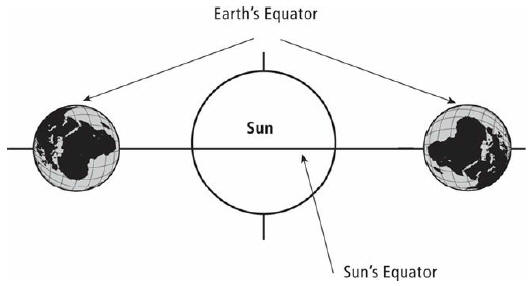
Figure 7
One of the poles, say the South Pole, would be permanently in
daylight
stuck for ever in a position equivalent to noon on midsummer's day
in central Africa. The Sun would blaze down from directly overhead
every minute of every day!
The North Pole on the other hand, would
be in a state of constant midnight. Indeed, all of the northern hemisphere would be in constant night and the southern in constant day.
The dark side of the planet would never warm up and it would be
frozen solid with
temperatures far below anything we actually experience. The region
that is currently between our equator and the Tropic of Capricorn
would see the Sun circling right around, low on the horizon once
each day.
Because of the angle of the sunlight through the atmosphere, there
would be very little warmth getting through and the entire region
would be covered in glaciers and swept with snowstorms driving down
from the dark northern hemisphere.
Antarctica would be utterly uninhabitable, being far hotter than
anywhere on our planet as we know it today. Only the southern tip of
South America, Tasmania, New Zealand and maybe the southern section
of Australia would have temperatures that were within a tolerable
range.
But it is hard to imagine what kinds of terrible weather
anyone living there would have to endure, with freezing ocean
currents moving from the north and very hot ones arriving from the
south. A state of permanent fog seems certain; which would in turn
block out the Sun.
If the Earth orbited the Sun in either of the two modes we have just
described, there would be no seasons at all - and almost certainly
no higher life
forms.
Thankfully we do have seasons, courtesy of the fact that the Earth
is actually at an angle of around 22.5 degrees relative to the
equator of the Sun. And that angle is maintained by the Moon, which
acts as a gigantic planetary stabilizer.
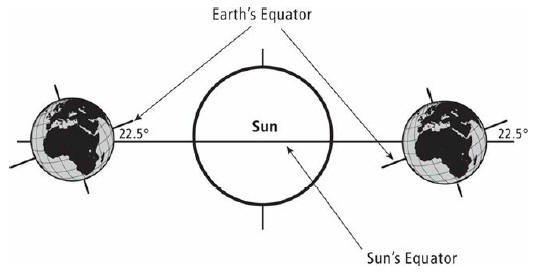
Figure 8
Because of this tilt, the northern hemisphere experiences summer
when the Earth is on that part of its orbit that angles it more
towards, the Sun. Therefore the Sun rises higher in the sky and is
above the horizon longer, and the rays of the Sun strike the ground
more
directly.
Conversely, when the northern hemisphere is oriented away
from the Sun, the Sun only rises low in the sky, is above the
horizon for a shorter period, and the rays of the Sun strike the
ground more obliquely.
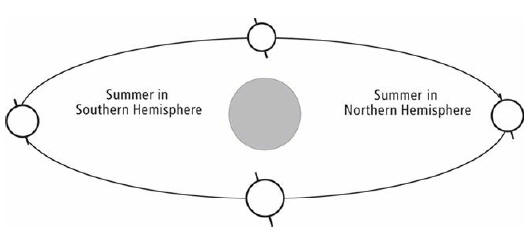
Figure 9
Whilst it is true that the extreme
polar regions of the Earth are frozen throughout the year, the tilt
angle of 22.5 degrees ensures that most parts of the Earth's surface
get a fair share of warm th throughout each year.
This in turn means
that by far the vast majority of water on the surface of the planet
remains in a liquid state. All of life is utterly dependent on water
and cannot exist without it. The band of temperatures at which water
is liquid is really very narrow. The oceans of the Earth would
freeze at around 1.91°C, with boiling point occurring at 100°C.
The Earth is therefore extremely well balanced. The coldest
temperature ever recorded was - 89.2°C (-128.6°F) at the Vostok
Station in Antarctica and the highest was 58°C (136°F) at El Azizia
in Libya. That is a range of absolute extremes of less than 148°C,
which is very little indeed in terms of the entire spectrum. The
coldest anything can get is known as 'absolute zero' when all
molecular motion stops. This occurs at a rather chilly -273.15°C
(-459.67°F).
On the other hand there is no known upper limit for temperature but
the hottest
temperature in our solar system is the Sun's core, which comes in at
an impressive 15,000,000°C
(27,000,000°F).
The norm al temperature range on Earth is such that there are very
few parts of the globe that cannot support human life. We have a
normal range of body temperature between 36.1 to 37.8°C (97 to
100°F) and yet the Inuit people live happily within the Arctic
Circle and the Bedouin travel the deserts
of North Africa.
The world's average temperature fluctuates slightly around the
14.5°C (58°F) mark, which is comfortable for physical work.
Of
course, some people will say that the world 'is' that temperature
and that we would not have evolved as we have if it were any
different - but this is flawed logic. We could just as well have
evolved in a world where only small sections of the planet were
available to us to inhabit. No other known planet has such a narrow
temperature band - and a range of temperature that permits water to
be liquid most of the time.
In fact water is a very curious substance altogether. On Earth we
can see it at the same time in its three states
as solid ice, as liquid water and as a gas in clouds. Each water
molecule is composed of just two
atoms of hydrogen and one of oxygen and yet it acts as a universal
solvent with a high surface tension.
Perhaps most surprising of all is how its density changes. Water has
its maximum density at
4°C which means that it not only gets lighter as it warm s from that
point - it also gets lighter as it
cools. As everyone knows, warm water rises as convection currents
but it is also true that ice
floats. Other planets in our solar system may have ice or steam but
only the Earth is awash with
life-giving liquid water.
Liquid water has been absolutely crucial in creating the world we
know today and, as far as is known, life cannot exist without it. As
surely as plate tectonics and the Earth's hot core constantly create
new mountain ranges, via volcanoes and the pushing up of mountains
as land masses meet, so water is mainly responsible for flattening
them again.
Constant weathering crumbles away the rocks as mountains age and water, in the form of rain, ice and snow, is
primarily responsible.
Liquid water, as streams and rivers, also
disperses the weathered rock, carrying it down to the plains where
it is distributed across flatter land, bringing much needed
nutrients to nourish life. Even more nutrients are carried by the
rivers to the oceans where they offer the necessary food for aquatic
plants that stand at the bottom of the oceanic food chain.
Of course, none of this would be possible if the vast majority of
water on the Earth was not in a liquid state.
Only two per cent of
Earth's water is locked up in glaciers and the icecaps, with
ninety-seven per cent being the water of our seas and oceans and
just one per cent available for hum an consumption as fresh water.
With only a small change in the overall temperature of the Earth,
or an alteration in the seasonal patterns, the nature of the water
on our planet would change.
As we have seen, a m ore pronounced
planetary tilt could well lead to a freezing of the oceans. This
would result in an overall loss of temperature at the surface of the
planet, with even greater freezing.
On the other hand, if the Earth were not tilted at all, the
equatorial regions would become unbearably hot and weather patterns
across the planet would be radically changed. In addition, the
biodiversity, that scientists are now certain has been so important
to our evolution, might never have developed in a world with more
polarized areas of temperature.
It has therefore been vital for our existence that the tilt of the
Earth has been maintained at around 22.5 degrees for an extremely
long period of time, and yet, bearing in mind the composition of the
planet this is a very unlikely state of affairs. Venus is the
nearest planet to Earth and the most similar to our own, but it has
toppled over in the past and other planets in the solar system show
signs of having varied markedly in their tilt angle across time.
The
Earth is very active internally and highly unstable, yet, despite a
few periodic wobbles, it keeps the same angle relative to the Sun.
Astronomer Jacques Laskar, a Director of Research at the National
Scientific Research Centre (CNRS) and head of a team at the
Observatory of Paris is in no doubt that the Earth would indeed
topple over, if it were not for the presence of the Moon! 18
With computer modeling, Laskar showed in 1993 that all the other
Earthlike planets (Mercury, Venus and Mars) have highly unstable
obliquity, which, in the case of Mars for example, varies wildly
across time between 0 degrees and 60 degrees. The same computer
modeling indicates that in the case of the Earth the obliquity
would vary even more, between 0 degrees and 85 degrees
but for the stabilizing influence of our incredibly large Moon.
Nobody knows for certain how long it would take for the Earth's
obliquity to change significantly if the Moon was not exerting such
a massive influence. There is a constant transfer of energy taking
place between the two bodies, which in addition to stabilizing
Earth's obliquity has also significantly slowed our planet's rate of
spin.
This constant obliquity has made the Earth a perfect crucible
for advanced life by providing many millions of years of stability
for life to develop from its simplest form to the complex patterns
it adopts today.
Although the Earth is significantly more massive than the Moon, the
Moon is still a very large body. Tides in Earth's oceans, seas and
lakes are caused by the gravitational interaction of the Earth, the
Moon and the Sun. Tides have an effect on dry land as well as oceans
but this effect can only be detected by careful measurement.
Solar
tides (the point of greatest gravitational pull by the Sun) are
twelve hours apart but since the Moon is also moving, lunar tides
are slightly m ore irregular, occurring every 12.42 hours on
average.
The height of tides in any particular part of the ocean is dependent
on a number of factors such as the shape of any nearby landmasses
and the depth of the seabed.
In some areas of the world, tides
hardly seem to lift the level of water at all - this is just as well
for some low-lying places such as the islands of the Maldives in the
Indian Ocean because their average height above sea level is less
than one meter.
In other places, like the British coast, tides can
have a huge range between high and low water.
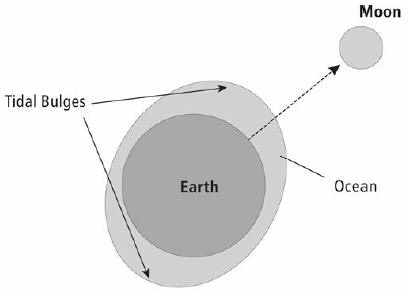
Figure 10
LUNAR TIDES
Lunar Tides
The Moon has sufficient gravity to pull a bulge of water from the
oceans of the Earth closest to its position towards it. It also
distorts the Earth, creating a corresponding bulge in the oceans on
the opposite side of the Earth.
Because of the Earth's rotation the
bulge on the Moon side runs slightly ahead of the Moon.
Tides would not cease if the Moon were not present because they are
also created by the Sun. However, they would be very much lower than
they are now because although the Sun is massive and the Moon much
smaller, the Moon is extremely close and the Sun much more distant.
It is the interaction of solar and lunar tides that makes it rather
complicated to predict when tides will occur and how high or low
they are likely to be.
The highest of the lunar tides occur when the Moon is either in its
full or new mode,
because at such times it is in line with the Sun and its
gravitational forces are added to those of
the Sun. Much lower tides are on the first and last quarters of the
Moon when the gravity of the
Moon and the Sun are working against each other.
Life in the tidal margins of the oceans and seas has evolved to
take advantage of tides, either in a daily or a monthly sense. Some species of crabs for example, lay their eggs in the sand at the
high-water mark at the time of the full or new Moon so that they
will be safe from marine predators during incubation.
There are
also many creatures that leave the ocean on the high tide at night
to scavenge in the inter-tidal margins, before seeking safety with
the next high tide.
Many shellfish are absolutely dependent on the ebb and flow of the
tides for the purpose of feeding and it was shown in the 1960s that
oysters are sensitive enough to be aware of the Moon's position,
either overhead or at the opposite side of the planet.
Oysters,
which obviously have no eyes, were taken from the ocean and placed
in tanks in the Rocky Mountains where they began to open and close,
as they would have done in the ocean, had it extended so far inland.
Because other stimulus such as current or wave motion were absent,
it suggests that they are able to feel minute increases and
decreases in the gravitational pull of the Moon and the Sun.
If mollusks, our very distant evolutionary cousins, can somehow
sense such astronomical
movements - then there would seem to be no reason why humans would
not be able to do the same. This just might point the way forward in
investigating a possible causation for variations in human behavior
according to the phase of the Moon.
It probably is not too surprising that some creatures have learned
to exploit tides, which are tiny these days in comparison with the
remote past when the Moon was much closer to the Earth.
The
tremendous forces created by a very close Moon would have generated
much heat and might even have caused parts of the Earth's surface
to melt. However, this phase did not last all that long because the
very transfer of energy that promotes tides is also causing the
Moon to drift further and further away from the Earth.
This happens
because the Earth rotates around its own axis m ore quickly than the
Moon revolves around the Earth.
The rapid rotation means that the tidal bulge of the Earth forward
of the Moon, (see figure 11) is always ahead of the Moon's position.
The tidal bulge exerts a pull on the Moon and this increases the
Moon's overall energy. Meanwhile, friction between the Earth's
surface and its own oceans is actually slowing the rate of Earth
rotation.
It is not much, but it does amount to around 0.002
seconds in a century.
The end result of this dance will be that the Moon will continue to
move
away from the Earth until a situation of equilibrium is achieved,
which is expected to happen in about fifteen billion years. The Moon
will then be 1.6 times further out from the Earth than it is now and
the Earth will have a solar day that is equal to the orbit of the
Moon, which by then will be fifty-five days.
However, we do not have
to lose too much sleep about this eventuality because the Sun will
have become a red giant about a billion years before that, at which
time the Earth will have ceased to exist in any case.
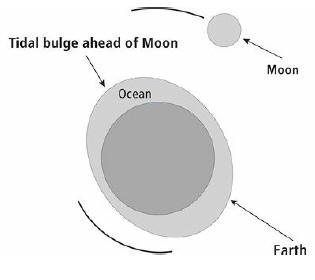
Figure 11
As the Earth revolves, it takes the tidal bulges with it, but
because of the gravity of the Moon, the water in the bulges is
trying to travel in the opposite direction.
As a result, waves
ground on the bottom of the oceans and on seashores, causing
friction. The friction slows the Earth and the energy is passed to
the Moon, which responds by speeding up. As it does so, the laws of
physics dictate that its orbit must
widen.
Over huge periods of time the
relationship between the Earth and the Moon changes, so we find
ourselves living in what amounts to a 'tiny snapshot' of the overall
situation. At present the Moon takes 27.322 days to go around the
Earth and because the Earth is also going around the Sun, full and
new Moons are ruled by a slightly longer cycle that takes 29.53
days.
Both these figures have been significantly different in the
past and will be different again in the future but the changes are
very slow and, according to NASA, the Moon is becoming more distant
from
the Earth by around 3.8cm per year.
Perhaps it is just as well that an expanding Sun will overtake us
before the Moon does get to its final position relative to the
Earth.
By the time the Moon and the Earth reach their ultimate
stations, the Moon will be too distant to exert enough influence on
our planet to keep its obliquity steady. Bearing in mind the Earth's
unstable core, this would almost certainly mean rapid and perhaps
catastrophic changes in both obliquity and climate.
Neil F. Comins, Professor of Physics and Astronomy at the University
of Maine, has written
about the consequences if the Moon did not exist. He explains that
the Earth would be turning so fast that a day would take just eight
hours and complex life would not exist yet.
If higher life forms did
eventually manage to evolve, such creatures would be very different
to us without, for example, any communication through speech.19
One thing is certain then: no Moon
would mean no humans!
Back to Contents
|






